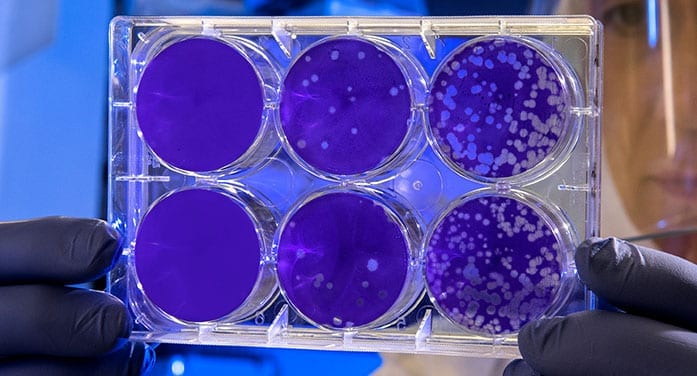A University of Alberta laboratory has uncovered the mechanism of action for a recently approved influenza drug in newly published research.
The scientists discovered that the drug baloxavir marboxil binds highly efficiently to an enzyme that is key to how the influenza virus replicates inside an infected patient. They also showed how a mutation of the influenza virus, which can occur during treatment, resists the drug.
“There is a single mutation in the replication complex which diminishes the drug’s efficacy so it can’t bind as tightly,” said lead investigator Matthias Götte, professor and chair of medical microbiology and immunology in the Faculty of Medicine & Dentistry.
“What we need to do now is develop compounds that will form a stable complex with the enzyme even in the presence of this mutation,” Götte said.
Götte credited his PhD student Brendan Todd and research associate Egor Tchesnokov with developing tools to evaluate drug binding and inhibition, outlined in the paper.
Baloxavir marboxil is approved in the United States and Canada for use against influenza infection, and in clinical trials it was shown to speed up recovery when compared with the placebo group. In the U.S., the drug is also used to prevent flu infections from spreading in families; if one member of a household gets the flu, the rest of the family can take the pill to prevent disease.
Götte’s lab also discovered the mechanisms of action for remdesivir, the first antiviral approved to treat the virus SARS-CoV-2, which causes COVID-19. Götte is a member of Canada’s COVID-19 Therapeutics Task Force, which advises the government on potential treatments during the pandemic.
Remdesivir must be given intravenously, which means it is only available to hospitalized patients. A high priority for research is to discover a drug to treat SARS-CoV-2 that can be administered orally in a single dose, as baloxavir marboxil is for influenza, said Götte.
“This is ongoing research,” he said. “We are not close to a silver bullet at the moment.”
The emergence of viral variants that reduce the efficacy of antiviral drugs or vaccines is always a concern, Götte noted. Drugs don’t cause these mutations, he said, but they can reveal mutations through a process known as selective drug pressure.
“Usually we are not infected with a single viral species – we are infected with millions of variants, and they all differ by a few mutations,” he said. “Most variants cannot survive in the presence of a drug like baloxavir, but some will be resistant to the treatment.
“Soon that variant will take over the population, so the next individual is eventually infected with the resistant virus.”
The newly described SARS-CoV-2 mutations have emerged in the absence of drugs, Götte said, but they seem better adapted to the environment and can become dominant. And though they are still being studied, he said the nature of these variants suggests they could affect vaccine efficacy and antibody treatment.
The findings on baloxavir marboxil illustrate the need to stay ahead of viral variants with drug treatments, Götte said.
“Influenza infection has been around for a long time – the Spanish flu pandemic was more than 100 years ago – yet we still struggle with treatment.”
One way to counteract drug resistance may be to use a combination of therapies, much like the cocktail of drugs used to treat human immunodeficiency virus (HIV) infection.
“About 12 years after the discovery of HIV, scientists figured out how to combine drug treatments so we could virtually eliminate all replication and it is really hard for the virus to adapt,” he said.
“We have to stay one step ahead, and that is not easy.”
The study, “The active form of the influenza cap-snatching endonuclease inhibitor baloxavir marboxil is a tight binding inhibitor,” was published in the Journal of Biological Chemistry.
| By Gillian Rutherford for Troy Media
This article was submitted by the University of Alberta’s Folio online magazine. Folio is a Troy Media![]() Editorial Content Provider Partner.
Editorial Content Provider Partner.



